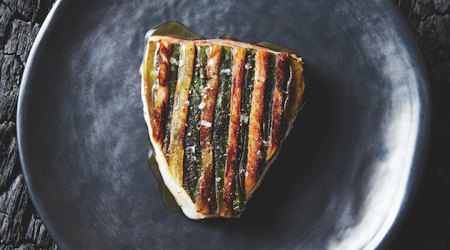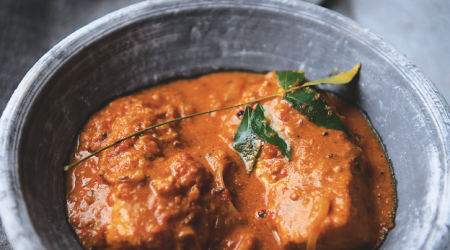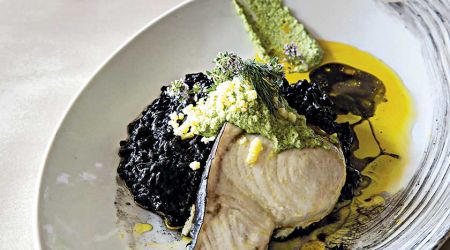Swordfish
Meaty, succulent and mildly sweet, swordfish promises to be a dinner-party winner, with our exclusive new recipes providing the perfect inspiration. Clarissa Hyman looks sharp
What you see is what you get: angry, fierce, predatory. It's a don’t-mess-with-me look that warns, ‘come any closer and you’re gonna get slashed with the mighty sword that is my lethal blade’. So no jokes about Pinocchio, please, or you’ll be pinned on the sharp end like an olive on a cocktail stick. Solitary and aggressive, the swordfish is a lean, mean, fighting machine that will frequently attack before it’s attacked.
One of the world’s great oceanic fishes, it is found in tropical and temperate seas with a wide range from south to north. They can grow to 4.5m, with the giant flat and pointed sword making up a third of that. Their Latin name is Xiphias gladius, which, of course, makes you think ‘gladiator’, although there is in fact some doubt as to whether the fish actually kills with the sword or just causes chaos in order to confuse a shoal of smaller fish.
There are tales about how swordfish, which seem to possess an impulse to attack objects larger than themselves, would embed their swords deep into the wooden hulls of sailing ships. The theory is that boats look as large as whales to the swordfish: it may sound a stretch but off the Calabrian coast they were hunted by boats with sleek, fish-shaped hulls. The boats had 30m-high masts, from where four speculatores would scan the horizon for the tell-tale ripples of fish swimming near the surface in order to give advance warning to the fishermen at the prow.
The method of catch, in some ways, has changed little since classical times, when the fish was hunted by harpoon or caught in one-direction-only tunny traps. Centuries ago, Sicilian fishermen would utter a Greek sentence as a charm to lure the swordfish to their boats: as legend has it, if the fish overheard a word of Italian, it would plunge down to deep water and swim off to safety. A more prosaic explanation is that the Sicilians were, and are, particularly skilled at catching them.
A court case took place in 1868 to decide whether the ship Dreadnought had been holed by a swordfish and could thus be deemed an insurable risk. On the one hand there was a 2.5cm hole in her side plus circumstantial evidence as to the cause but the case was lost because there was no historical record of a swordfish being able to extricate itself once it had driven its sword into a wooden boat.
Swordfish migrate between temperate and tropical waters and are usually caught at night when they rise to the surface to feed. Although large and well armed, the swordfish often lazes on the surface of the water in an exposed and vulnerable way that enables it to be harpooned or caught by long lines. As they are a very valuable commercial species, they have been heavily overfished in the past, especially in the Mediterranean, where some fleets controversially still use indiscriminate drift nets. However, a number of swordfish fisheries in the Atlantic and South West Pacific have been certified as well managed and sustainable by the Marine Stewardship Council (MSC), and the fish carry their accredited blue label.
They are a handsome fish; dark above and white with a silvery sheen below. The pale pink flesh can be tinged with orange when raw, the colour varying according to diet and habitat. It is sold in ‘wheels’ that display the unique whirling patterns in the flesh. The 18th-century botanist Carl Linnaeus paid the swordfish a compliment when he compared the succulent flesh to that of salmon, although the former is creamy-white and firm and has a fine grain when cooked. Swordfish steaks are delicious grilled, and are also excellent simply cooked à la meunière.
Alan Davidson describes in the classic Mediterranean Seafood how the Turks would traditionally salt swordfish for 18 hours or so before rinsing in seawater and then smoking over oak shavings for ten to 12 hours. Other favourite Turkish ways of cooking swordfish include marinating in oil, lemon juice and paprika before grilling on skewers, as well as baking slices with juicy tomatoes. Smoked swordfish is also produced near Lisbon, Portugal, where it is served in very thin slices not unlike a stronger, saltier version of smoked salmon. A hearty Spanish fishermen’s swordfish stew from the Murcia region includes saffron, potatoes, green peppers and thin vermicelli noodles. Traditionally, they would include picos: strong, oily chunks of meat cut from the head. A famous Sicilian swordfish pie mixes the fish filling with tomatoes, celery, green olives, capers and fried courgettes.
Rick Stein recommends simply searing swordfish steaks with salmoriglio, an emulsified sauce of oil, water, lemon juice, garlic and herbs, and serving with a tomato, pepper and coriander salad; Gennaro Contaldo steams and griddles the fish and pairs it with a mint and marjoram sauce.
The swordfish remains a mysterious customer: its methods of reproduction are still not understood, for example. Alone and on the prowl, formidable and fast-moving, like The Godfather, the swordfish deserves respect. Or you just might end up swimming with the fishes.
Note: Children, pregnant women and women who are trying to get pregnant should not eat swordfish, because it contains more mercury than other fish.

Recipes
Get Premium access to all the latest content online
Subscribe and view full print editions online... Subscribe







